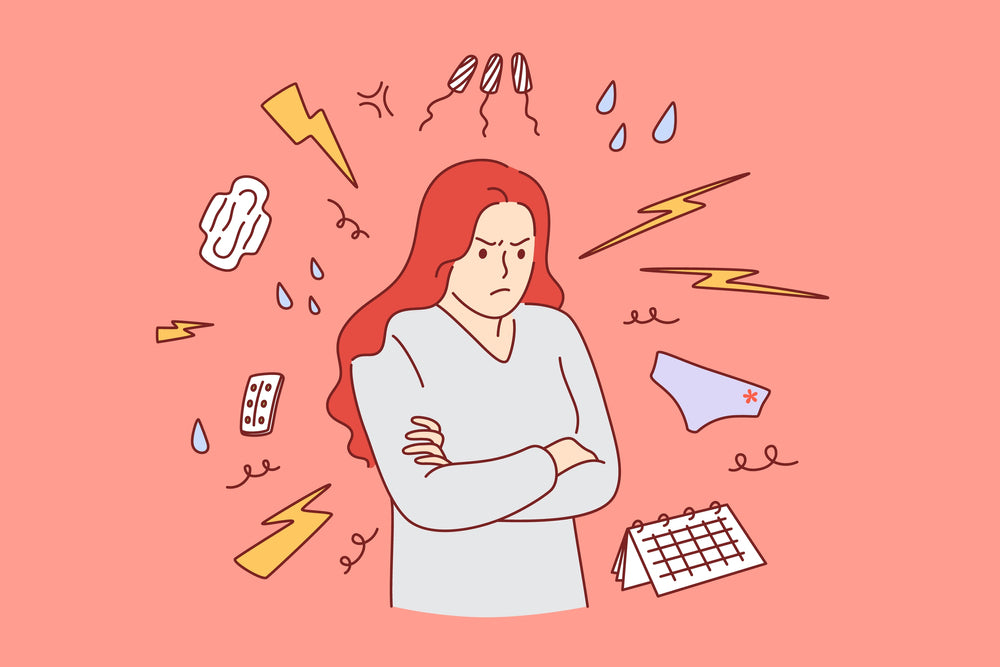Premenstrual syndrome (PMS) is a common experience for many menstruating people. It can cause a variety of physical, emotional, and behavioural symptoms that can range from mild to severe. PMS symptoms usually start one to two weeks before your period, and typically go away a few days after your period begins.
While PMS is a normal experience, it can be uncomfortable and difficult to manage. However, understanding how PMS symptoms change over time can help you manage them better. PMS symptoms can change throughout your lifetime, and factors like pregnancy, stress, sensitivity to hormonal changes, perimenopause, and menopause can all play a role in how you experience premenstrual syndrome.
In Your 20s
PMS symptoms typically start in your 20s. Your menstrual cycle becomes more regular than what you may have experienced as a teenager. As a result, you may notice a more stable pattern with your PMS symptoms. PMS symptoms vary from person to person. For example, some may see regular patterns of bloating and irritability, while others experience back pain and increased food cravings. Overall, PMS symptoms are thought to be milder in your 20s than in later years.

Women in their 20s may also be more likely to use hormonal contraceptives such as birth control pills, shots, or implants to stop ovulation. The two hormones that make up hormonal contraceptives are estrogen and progesterone, which are naturally found in your ovaries. Taking hormonal methods of birth control may help relieve PMS symptoms, which can contribute to a milder PMS experience in your 20s.
If you notice significant changes in your normal PMS symptoms in your 20s, you may want to reach out to your healthcare provider to determine the cause of these changes and rule out other health conditions.
In Your 30s
Generally, you can expect PMS symptoms in your early 30s to resemble your 20s. PMS symptoms may begin to worsen during your late 30s, as you approach perimenopause.
PMS symptoms in your 30s may also worsen if you have given birth, have a history of postpartum depression, have a family history of depression, or have a personal history of an affective mood disorder such as depression or bipolar disorder.
Some people may experience severe PMS symptoms as a result of premenstrual dysphoric disorder (PMDD), a condition that is more likely to appear in a person’s late 20s and 30s. PMDD occurs in less than 5% of people who menstruate. PMDD symptoms may appear one to two weeks before your period, and are more intense than PMS symptoms. PMDD symptoms can include intensified irritability or anger, depression, anxiety, panic attacks, loss of interest in activities, and even suicidal thoughts.

In Your 40s
You may notice your PMS symptoms worsen as you go through perimenopause. Perimenopause typically begins in your mid to late-40s and typically lasts for four years before your periods stop completely–what’s known as menopause.
Hormone levels fluctuate during perimenopause in unpredictable ways, causing periods to become irregular. These changes can affect ovulation, the length of your cycle, and the heaviness of your period. Your normal PMS symptoms may become more intense during this time and can be accompanied by hot flashes and vaginal dryness.
If you notice your mood is especially sensitive to hormonal changes during your menstrual cycle, you may find that your PMS symptoms also worsen during perimenopause.
Once your periods stop, PMS symptoms will stop too. However, some symptoms of menopause can be similar to those of PMS.

To manage PMS symptoms, you can make lifestyle changes like eating a balanced diet, limiting your salt and sugar intake, staying hydrated, getting enough sleep, exercising, and managing stress. You can also consider medication or a combination of both. And if you're having trouble managing your symptoms, don't hesitate to reach out to a healthcare provider.

